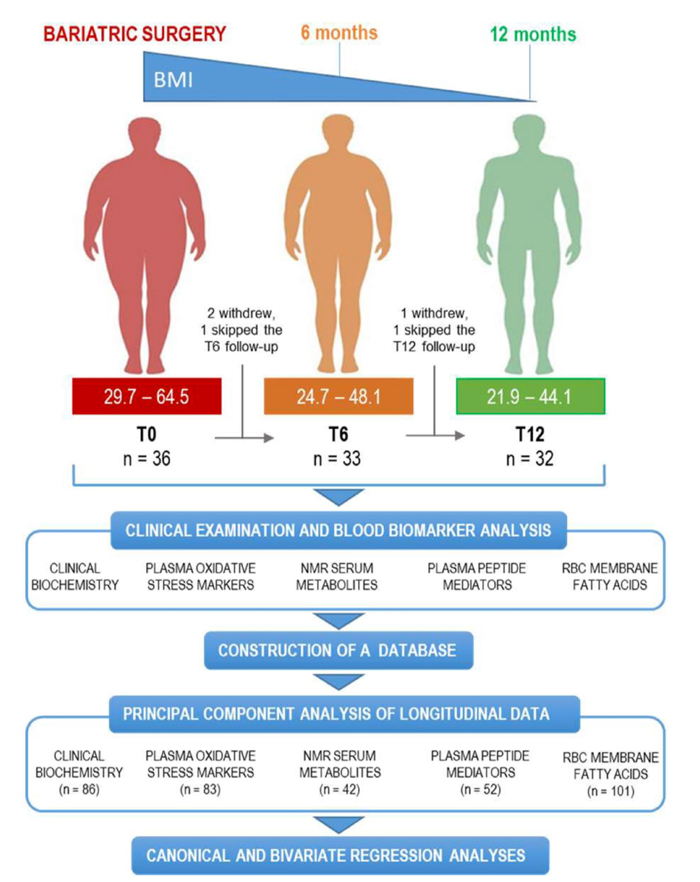
BARIATRIC SURGERY

![]()
Risks and benefits of bariatric surgery
The abnormal accumulation of visceral fat in obesity generates a number of metabolic consequences that can be sum up into three major groups:
– the onset of a chronic low-grade inflammatory condition;
– the increase in the concentration of fatty acids in the bloodstream;
– the increase in oxidative stress.
The direct consequences of these molecular alterations are insulin resistance in adipose tissue, muscle, and liver and increased risk of developing 2nd type diabetes, metabolic syndrome, and cardiovascular disease. Chronic low-grade inflammation also explains the association between obesity and some type of cancer.
The intervention of choice in obesity is on the patient’s lifestyle (exercise and nutrition) in combination with drug therapies. However, in cases of severe obesity (defined as BMI>40), this approach is not sufficient. Therefore, BARIATRIC SURGERY is resorted to as a treatment to reduce excess weight, comorbidities, and, therefore, risk factors associated with the patient’s weight and metabolic condition.
In this recent article published in the prestigious NATURE Scientific Report are the results of a multidisciplinary work on patients undergoing bariatric surgery and follow-up at 6 and 12 months in which Lipinutragen and the Company’s founding CNR researchers participated.
The objective was to perform mutually complementary molecular analyses and to study the impact of severe obesity and bariatric treatment through the panel of biomarkers related to metabolic, endocrine, inflammatory, neurological, and cellular aspects.
The importance of the study lies in both the type of analyses that were performed and the length of follow-up of subjects comparing the effects at 6 months and up to 1 year post-surgery.
The integration of high-throughput technologies, including MEMBRANE LIPIDOMICS on mature red blood cell, allowed us to unravel the molecular mechanisms of the body’s response to weight gain and surgery, revealing their interconnections and the dynamics that relate them.
The clinical study

Between 2017 and 2019, 36 subjects with severe obesity (33 women; mean age 47.1 ± 10.8 years; mean BMI 44.3 ± 6.9 kg/m2) were enrolled at the outpatient service of the Obesity Center of the University Hospital ‘Policlinico Tor Vergata’ (Rome, Italy) for prior clinical evaluation and inclusion in the study. All enrolled patients sustained laparoscopic bariatric surgery, mostly with restrictive procedures. Before surgery, 6 and 12 months later, all participants sustained a complete medical evaluation and collection of blood samples for biomarker measurement.
The study involved integrative analysis of biomarkers belonging to five physiological domains: clinical, oxidative stress, energy metabolism, peptide mediators of immunity, and mature erythrocyte cell membrane lipids.
Main scientific results
The authors reveal that significant clinical and metabolic improvements occur in the first 6 months after bariatric surgery, but then the body slowly achieves a new equilibrium with some metabolic and nutritional disorders still persisting or newly emerging.
The most important evidences emerging from the study are:
1) anthropometric indices (Weight, BMI, waist circumference) and insulin sensitivity improve rapidly at 6 months after surgery, correlating with metabolic function of adipose tissue and skeletal muscle (improves peripheral insulin sensitivity);
2) in the 12 months following surgery, there is evidence of an early and lasting effect of reducing systemic inflammation, oxidative stress associated with lipid metabolism, and modulating the immune response;
3) systemic oxidative stress status appears to be correlated with all other physiological domains analyzed in this study indicating that the relevant biomarkers are not only a hallmark of severe obesity status, but can also be considered useful tools for monitoring the health status of patients undergoing bariatric surgery.
Results from lipidomics
The results of lipidomic analysis in patients at 6 and 12 months after surgery show that the membrane composition of the mature red blood cell is mainly determined by nutritional status, on the one hand, and cholesterol metabolism and related disorders, on the other.

In detail, the balance of red blood cell membrane fatty acid composition is partially restored with significant reduction of excess palmitic acid (saturated, 16:0) and dihomo-γ-linolenic acid (DGLA, omega-6). However, polyunsaturated fatty acid (PUFA) deficiency, along with a post-surgical increase in arachidonic acid, highlights some unresolved problems in lipid intake and processing that potentially make the patient more susceptible to an inflammatory state.
Improved insulin sensitivity and weight loss, highlighted by the study following bariatric surgery, are associated with increased activity of membrane fatty acid processing enzymes (elongase-6 and delta5-desaturase) indicating (re)activation of omega-6 saturated and polyunsaturated fatty acid metabolism.
Concomitantly, a significant decrease in red blood cell membrane SFA/MUFA ratio was observed, not correlated with improvement in either weight status or insulin sensitivity, but strongly associated with nutritional status. The rapid and persistent normalization of the SFA/MUFA ratio in the mature red blood cell membrane of patients undergoing bariatric surgery results from a diet-dependent mechanism that is also independent of glucose metabolism.
Conclusions
In general, bariatric surgery leads to better health, however, it is not a cure. Indeed, a year after surgery, some disturbances in cholesterol metabolism associated with pro-inflammatory and pro-oxidative processes as well as metabolic alterations and nutrient deficits may occur, as shown by alterations in the membrane lipidomic profile in essential fatty acids (linoleic acid) and PUFA polyunsaturated fatty acid paths.
From these results, we come to the conclusion of the importance of membrane lipidomic analysis, which is closely related to the finding of metabolic-nutritional balance and also provides important suggestions for implementing the personalization of dietary regimens.
Article by the Editorial Group of Lipinutragen
The food recommendations in the article are not intended as a substitute for a personalized food plan and are to be adapted to specific cases.
Bibliography
Palleschi, S., Guglielmi, V., Nisticò, L. et al. A multi-marker integrative analysis reveals benefits and risks of bariatric surgery. Sci Rep 12, 18877 (2022). https://doi.org/10.1038/s41598-022-23241-6
OPEN ACCESS article downloadable here: https://www.nature.com/articles/s41598-022-23241-6
Additional information:
https://static-content.springer.com/esm/art%3A10.1038%2Fs41598-022-23241-6/MediaObjects/41598_2022_23241_MOESM1_ESM.pdf
Photo: 123RF Archivio Fotografico: 167318227 : ©collagem
- On 5 December 2022



